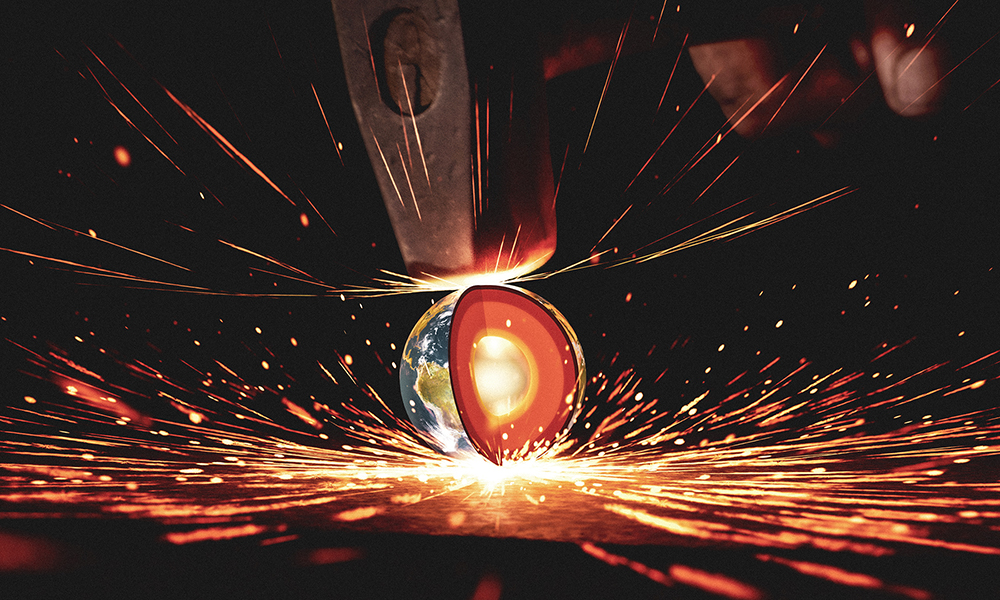
July 28, 2022
The phase changes that materials undergo during experiments at extreme conditions can shed light on the formation and composition of exoplanets and other celestial bodies, including the inner core of Earth. University of Rochester researchers are helping develop automated deep-learning computer vision techniques to expedite the analysis of the trillions of bytes of data generated by these experiments. (Illustration by Greg Stewart/SLAC National Accelerator Laboratory.)
Rochester researchers will cut through excess data to speed the search for new materials.
The phase changes that materials undergo at extreme conditions provide scientists unprecedented opportunities to discover ways to create new materials. The changes can also shed light on the formation and composition of exoplanets and other celestial bodies, including the inner core of our Earth.
However, these phase changes occur during mere picoseconds. They also involve modifications to the crystalline atomic features that measure a mere tenth of a nanometer in size.
The paradox for experimental scientists is this: The better they become at recording these changes, or so-called “rare events,” the more inundated they become with “tons and tons” of data that are challenging to analyze, says Niaz Abdolrahim, an assistant professor of mechanical engineering at the University of Rochester.
Just a 10-second experiment, for example, can produce a sequence of millions of images. “I’m talking about terabytes (trillions of bytes) of data every day,” she says. Moreover, only a handful of these images capture the picoseconds at which a phase change occurs, Abdolrahim adds. “Having humans analyze these data would be really time-consuming and not very practical.”
Abdolrahim, a theoretical scientist with expertise in multiscale modeling of nanoscale materials, is the principal investigator on two grants—a $574,000 award from the US Department of Energy’s National Nuclear Security Administration (NNSA) and a $375,000 award from the National Science Foundation (NSF)—aimed at addressing this problem.
The goal is to develop automated deep-learning computer vision techniques that can expedite the analysis of this data while quickly identifying the most important images for experimental scientists.
Her collaborators include coprincipal investigator Chenliang Xu, assistant professor of computer science, and Rip Collins, director of the Center for Matter at Atomic Pressures, both at Rochester, and Arianna Gleason at the Linac Coherent Light Source (LCLS) at the SLAC National Accelerator Laboratory in Menlo Park, CA.
Modeling with ‘synthetic’ and experimental data
LCLS and other national labs use ultrafast x-ray diffraction spectroscopy to illuminate material undergoing changes at extremes of pressure and heat. The spectroscopy aims an x-ray beam at a crystalline structure, or lattice, at extreme conditions. This causes a reflection of scattered x-ray beams at picosecond intervals showing the structure’s symmetry, size, and other pertinent atomic features. The features show up as peaks and halos that can indicate whether a phase change is taking place.
The reflections are captured in millions of images for scientists to analyze.
A silicon target undergoes phase changes after being exposed to laser shock at SLAC National Accelerator Laboratory. X-ray data taken at 15-nanosecond intervals revealed the lattice dynamics. (Courtesy of SLAC Press Release for Brennan-Brown et al. 2019 Sci. Adv.)
To create deep-learning techniques that can automatically find the most relevant of these images, the researchers first need to “train” the deep-learning models with raw data. Ideally, the researchers would generate experimental data at advanced labs for this purpose, but that would be expensive and involve too many uncertainties, such as experiments going awry, Abdolrahim explains.
So, in the initial stages of the NNSA project, her lab will generate “synthetic data”—data generated by computer simulation that approximates as closely as possible what might be expected to occur in an actual experiment. “This is where we will work with Xu and his lab to develop a model, modifying it back and forth, until it works with our data,” Abdolrahim says.
In later stages of the project, the researchers will then further adapt the model with actual experimental data in collaboration with LCLS.
“This will tell us, when we look at x-ray diffraction data, what the crystal structure of the material is, any phase changes that occur during the process, and if they happen, at what point,” Abdolrahim says. “Our work will greatly facilitate that of experimentalists, who otherwise might spend a month or more trying to analyze the data on their own.”
Adapting the framework for larger data sets
With the NSF award, Abdolrahim and her collaborators will adapt their learning models with more complex video-segmentation algorithms so the models can be trained on even larger experimental data sets.
“Here, we will use both 1D (one-dimensional) and simulated 2D (two-dimensional) x-ray-diffraction data to identify dynamics of plastic deformation, phase transformation, and defect generation,” Abdolrahim says.
The project will include performing simulations of molecular dynamics to generate dynamic 1D and 2D data, and adapting the models to a variety of different experimental data with varying characteristics.
The overarching goal of both projects is to “gain a better understanding of how materials react at extreme pressure, and why new exotic properties or phases are happening. This will help us identify novel pathways for designing new materials,” she says.
Both projects were launched with the support of a University Research Award (URA) seed grant received by Abdolrahim and Xu. “If it wasn’t for the URA, we might never have started the discussion,” Abdolrahim says. “It was really helpful for facilitating the collaboration and generating these ideas.”
Read more
Using machine learning to understand climate changeIn a vast ocean where direct observational data is scarce, Rochester researchers are using data science to understand how shallow coastal waters and deep oceans contribute to the methane found in the atmosphere.
Tags: Department of Mechanical Engineering, Hajim School of Engineering and Applied Sciences, Niaz Abdolrahim, research fundingCategory: Science & Technology
Source: https://www.rochester.edu/newscenter/machine-learning-pinpoints-when-matter-changes-under-extreme-conditions-527492/